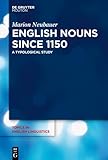English Nouns since 1150 : A Typological Study / Marion Neubauer.
Material type: TextSeries: Topics in English Linguistics [TiEL] ; 115Publisher: Berlin ; Boston : De Gruyter Mouton, [2024]Copyright date: 2024Description: 1 online resource (XV, 254 p.)Content type:
TextSeries: Topics in English Linguistics [TiEL] ; 115Publisher: Berlin ; Boston : De Gruyter Mouton, [2024]Copyright date: 2024Description: 1 online resource (XV, 254 p.)Content type: - 9783111317472
- 9783111317908
- 9783111317717
- online - DeGruyter
- Issued also in print.
| Item type | Current library | Call number | URL | Status | Notes | Barcode | |
|---|---|---|---|---|---|---|---|
 eBook
eBook
|
Biblioteca "Angelicum" Pont. Univ. S.Tommaso d'Aquino Nuvola online | online - DeGruyter (Browse shelf(Opens below)) | Online access | Not for loan (Accesso limitato) | Accesso per gli utenti autorizzati / Access for authorized users | (dgr)9783111317717 |
Frontmatter -- Acknowledgments -- Contents -- List of figures -- List of tables -- Abbreviations and symbols -- 1 Introduction -- Part 1: Morphological typology and the English lexicon -- Introduction -- 2 Morphological typology -- 3 Typological shifts in the English lexicon -- Part 2: Means to extend the nominal lexicon since 1150 -- Introduction -- 4 The database -- 5 New additions to the lexicon -- 6 Word formation patterns -- Part 3: Typological profile of the nominal data since 1150 -- Introduction -- 7 Overall development of syntheticity -- 8 Typological subtypes: Between isolation and fusion -- 9 Changes in syntheticity and analyticity -- 10 Typological shifts in lexical structure and word formation -- Part 4: Discussion and conclusion -- 11 Typological trends in English morphology and beyond -- 12 Typology and change: Cognitive and sociocultural roots -- 13 Conclusion -- References -- Appendices -- Index
restricted access online access with authorization star
http://purl.org/coar/access_right/c_16ec
Morphological typology is usually limited to the realm of grammar. Accordingly, English is considered an analytic language due to its poor grammatical morphology – but what about the lexicon? Taking a twofold approach, this study investigates the typological development of English nouns since 1150. First, the focus is on the means used to extend the lexicon: Correlating the central noun formation processes as well as borrowing reveals, for the first time, their quantitative importance – with some surprising results. Second, the structure of the lexicon takes center stage: The morphological analysis of all nouns uncovers diachronic shifts – and striking parallels between grammar and lexicon.
Issued also in print.
Mode of access: Internet via World Wide Web.
In English.
Description based on online resource; title from PDF title page (publisher's Web site, viewed 20. Nov 2024)


